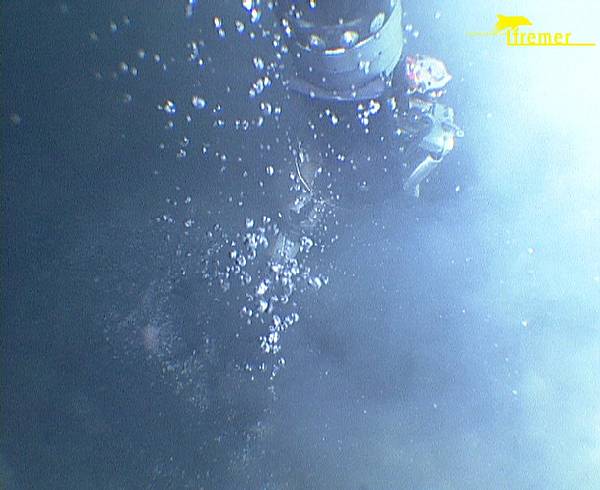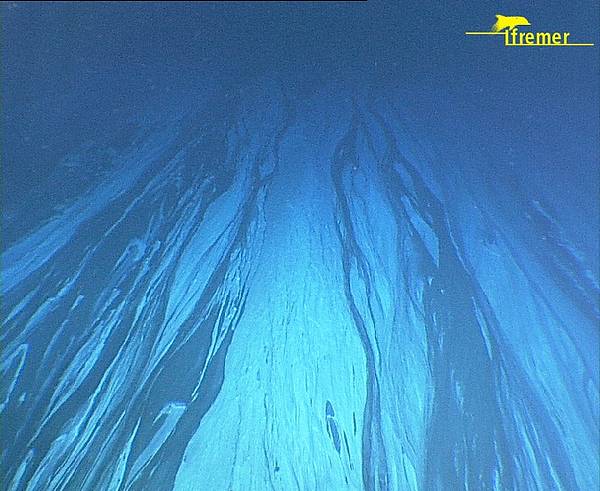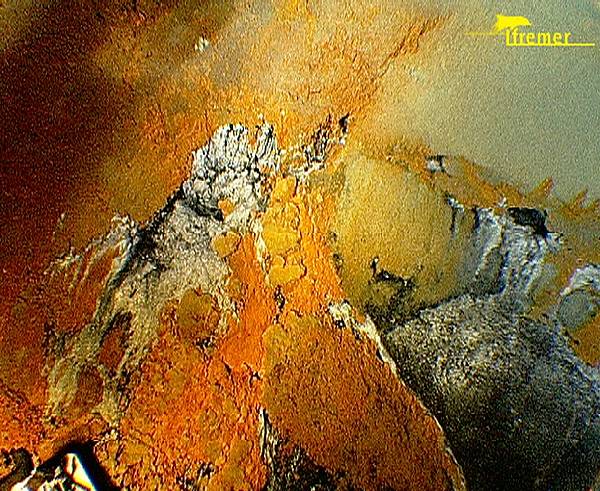At continental margins fluid and gases are emitted into the ocean via the seafloor. The forms of emissions extend from diffusive flow through the seafloor, to focussed flow through seeps and vents, and can be highly variable in time and space. Fluid seeps are highly dynamic sites where geosphere, biosphere, hydrosphere and atmosphere are linked. Seep fluids (liquids and gases) include hydrocarbons, carbon dioxide, nitrogen and hydrogen sulfide, in addition to water. These energy sources support distinct biological communities and chemosynthetic organisms. Currently, the global inventory of fluid seeps at passive continental margins is growing rapidly, but geological, chemical and biological processes operating at those fluid seeps remain little known. In this regard, important research tasks are deriving methane fluxes in their relevance to climatic changes, evaluation of fluid-triggered instabilities on continental slopes, and hydrocarbon geochemical prospecting in the deep offshore. MEDIFLUX proposes a comprehensive, transdisciplinary investigation of fluid seepage at a site exemplarily rich in a large variety of fluid escape structures on a passive continental margin, the Nile deep-sea fan. Objectives are (1) to describe the geographical distribution, types, geological formation and activity of fluid seeps of the Nile deep-sea fan, (2) to determine the composition of emitted fluids and use this information to infer fluid properties and fluid processes at depth, (3) to understand the controls and mechanisms of chemical element transport and breakdown by seep biota, and to obtain a well constrained budget of element cycling and export at fluid seeps.
MEDIFLUX Presentation
Objectives: MEDIFLUX is a comprehensive, trans-disciplinary investigation of fluid seepage at an exemplary site rich in a large variety of fluid escape structures on a passive continental margin, the Nile deep-sea fan. Objectives are (1) to describe the geographic distribution, types, geological formation and activity of fluid seeps of the Nile deep sea-fan, (2) to determine the composition of emitted fluids and use this information to infer fluid properties and fluid processes at depth, (3) to understand the controls and mechanisms of chemical element transport and breakdown by seep biota, and to obtain a well constrained budget of element cycling and export at fluid seeps.

Some background: The project has benefited at its launching time from the input of yet unpublished excellent quality multibeam bathymetry and seafloor imagery data provided by the research group Geosciences Azur in Villefranche-sur-Mer (now published in Loncke L., J. Mascle, Fanil Scientific Parties, Mud volcanoes, gas chimneys, pockmarks and mounds in the Nile deep-sea fan (Eastern Mediterranean); geophysical evidences. Marine and Petroleum Geology 21 (2004) 669-689). This data set revealed the high potential of fluid seepage through various mud domes and gas chimneys of the Nile deep-sea fan and provided the background information on which MEDIFLUX was constructed.
A coordinated program at sea: From the beginning of MEDIFLUX there has been an agreement between the Dutch, German and French partners to organize a large coordinated field acquisition program based on three major oceanographic expeditions, each country funding and leading one. This has been very successful. Two expeditions have been completed, NAUTINIL on the French vessel Atalante with the submersible Nautile in 2003, and MIMES on the Dutch vessel Pelagia with the deep-tow sonar DTS1 in 2004. A third expedition, BIONIL, on the German vessel Meteor with the Bremen ROV is scheduled in 2006. All the expeditions are carried out with a balanced participation of the partners, and all opportunities to meet (ESF forums, ESF workshops such as in Aveiro, international conferences such as EGU Nice) are used to present preliminary results and discuss on-going data interpretations and future work.
From sea bed exploration to field experiments: The NAUTINIL and MIMES expeditions were important steps towards achieving objectives of a detailed description of the geographic distribution, types, geological formation and activity of fluid seeps of the Nile deep-sea fan (Objective 1, see first paragraph above), and of a determination of the composition of emitted fluids of the Nile deep sea-fan (Objective 2). Work for Objective 3, to understand the controls and mechanisms of chemical element transport and breakdown by seep biota, has started with NAUTINIL and MIMES field observations, followed by extensive post-cruise laboratory investigations. This objective will be at the centre of the BIONIL expedition in 2006.
Towards a Nile deep sea fan European observatory of fluid seepage processes: Although the MEDIFLUX project is far from completion, the results so far obtained and presented (such as at the EGU Nice in 2005) attest to the high level (surprising to many of us) of natural brine, pore water, and hydrocarbon seepage through various mud volcanoes, mud and gas chimneys, making the Nile deep sea fan a field observatory of considerable interest to many European trans-disciplinary groups to conduct long term observations of fluid seepage through the seafloor of a continental margin, and investigate its impact on the deep ecosystem, in an hydrocarbon province.
NAUTINIL Summary Report
On board L’Atalante, 2 October 2003
The NAUTINIL expedition took place on the French research vessel L’Atalante in the eastern Mediterranean Sea from 3 September to 2 October 2003, starting and ending at the port of Iraklion, Greece. A total of 22 dives were made with the research submersible Nautile at depths ranging between 500 and 3000 metres. Besides the dives, 18 piston cores were taken with lengths between 6 and 15 metres, 16 of which were coupled with heat flow measurements using outrigger thermal probes, 13 hydrographic stations were made, each of which comprised 15 water samples of 10 litres at various levels in the water column, and about 3500 kilometres of reconnaissance geophysical profiles were completed with the EM12D multibeam swath bathymetry system and L’Atalante’s 3.5 kHz subbottom profiler.
The main objective of the NAUTINIL expedition was to evaluate the importance of seafloor fluid emissions (water, gas, hydrocarbons) and their effects on the deep ecosystem of the Mediterranean. More than 30 scientists – geologists, chemists, and biologists – coming from 12 laboratories in France, the Netherlands, and Germany participated in the research work which involved detailed observations at fluid emission sites, sampling of the emitted fluids and of the sediments, and description of both the associated benthic seep fauna and microbial communities.
Several sites showing three different types of potential fluid emission were identified initially from their acoustic signature in EM300 multibeam data from cartographic surveys made during the FANIL expedition in 2000 on the Nile delta and deep sea fan. These three types of emissions were found to be active and were thus explored in more detail. One of the sites, a zone in the western sector of the Nile deep sea fan known as the Menes caldera, at a depth of 3000 metres, discharges brines at a temperature of around 50°C. These brines form pools and lakes on the seafloor with dimensions reaching several dozens of metres on the mounts ‘Cheops’ and ‘Chefren’ situated in the interior of the Menes caldera. Intense microbial activity is observed around the brine lakes. Corresponding to a second type of emission, the mud volcanoes named ‘Isis’, ‘Osiris’, and ‘Amon’, in the eastern sector of the Nile fan at depths around 1000 metres, are characterized by elevated temperatures in the upper muddy sediments (more than 40°C at 9 metres below the seafloor in the centres of Isis and Amon) and intense degassing. Mud volcano North Alex, situated at a depth of 550 metres, was the focus of an exploratory dive during which intense degassing was observed in the form of bubbles of gas issuing from the seafloor within a radius of about 50 metres from the centre. The third type of fluid emissions is from a field of ‘pockmarks’ (shallow bowl-shaped depressions in the seafloor with diameters of the order of tens of metres and depths of a few metres) in the central part of the Nile fan at depths around 2000 metres. Observations made in several of the pockmarks found thick carbonate crusts and chemosynthetic seep fauna (vestimentiferan worms and bivalves) associated with the methane seeps.

The NAUTINIL expedition is the first phase of the European scientific project MEDIFLUX (2003-2006) within the Euromargins programme initiated and endorsed by the European Science Foundation. MEDIFLUX is coordinated by France and involves research groups from France, the Netherlands, and Germany. The second phase of the project to take place aboard the Dutch research vessel Pelagia in the summer of 2004 will continue the research during the MIMES expedition with different types of observations of the fluid emissions on the Nile deep sea fan (including sampling and geophysical surveys). The German expedition BIONIL, in preparation, will complete the project with further data collecting at sea.
 |
MIMES Summary Report
Limassol, Monday 12 July 2004
The MIMES Expedition on R/V Pelagia docked in Limassol on 12 July after a successful mission to investigate seafloor seeps and mud volcanoes in the eastern Mediterranean Sea, mainly on the Nile Deep Sea Fan. MIMES (Multiscale Investigations of Eastern MEditerranean Seep Systems) is a Dutch (NWO) funded contribution to the four year MEDIFLUX project in which France, Germany, and the Netherlands cooperate under the ESF umbrella of Euromargins As a follow-up to NAUTINIL, a French-coordinated expedition in September 2003 with the French submersible Nautile, MIMES aimed to add deeper sampling at locations examined and sampled by Nautile, provide detailed water column and sedimentary geochemical analyses, and use geophysical methods (principally the Edgetech DTS-1 deep tow system owned and operated by Geomar, Kiel, with additional 3.5 kHz echosounding) to characterize the seafloor in areas where ground truth observations from Nautile had been made.
During the period between 16 June when the Pelagia departed Iraklion to the end of the cruise on the 12 of July, 26 piston and 11 gravity cores were made – 22 of these core stations with thermal probes mounted on the core barrel, 5 box cores were taken with a video system mounted to provide guidance for reconnaissance and selected sampling of the seafloor, 10 SeaBird CTD casts and 3 CTD casts in briny mud pools on two mud volcanoes using an instrument adapted to this extreme environment (and with thermal probes attached), 5 deep tow deployments with 26 lines for a total of roughly 700 line kilometers, and 7 surveys of mud volcanoes with the 3.5 kHz echosounder totaling about 130 line kilometres. The work was carried out in 5 general areas with the concentration on two different environments on the Nile fan system – one over large gas chimneys in the east and one over a large caldera structure near the base of the fan in the west.
Brine pools on two mud volcanoes (Chefren and Cheops) in the 3000 m caldera site were particularly interesting. On the summit of Chefren there is a brine pool that is about 250 m across accompanied by soupy mud with a depth as great as 250 m, thus deeper than the seafloor surrounding the mud volcano. The temperature of the mud is as high as 57ºC throughout indicating both good mixing of the briny mud but also relatively high advection of fluids into the pool from below. There may, however, be some density stratification with the pool related to salinity and suspended matter variations, as suggested in the 3.5 kHz profiles; but such inferred variations need further examination along with more analysis of the CTD measurements. Cheops has a much shallower pool or pools (perhaps 7-15 m deep) with lower temperature brine (25º-42ºC depending on location) suggesting less vigourous activity than at Chefren; however there is a much higher concentration of methane in the water column above Cheops. The fluids appear to be different between Cheops and Chefren also, with Chefren having a much higher sulphide content and lower salinity than Cheops.
Above all the mud volcanoes where CTD casts were made are plumes of water enriched in methane and extending tens of metres upwards from the seafloor in association with elevated levels of turbidity in the water. Where a CTD cast was repeated during MIMES after an interval of a week, the levels of turbidity and methane were different which suggests variable activity of fluid emission, perhaps as short bursts at regular intervals, rather than as a continuous release of fluids at a constant rate from the seafloor. Plumes of free gas bubbles were observed in the water column above two mud volcanoes on sidescan sonar records where deep-tow surveys were made utilizing the Geomar DTS-1 Edgetech system. One surprising preliminary result from the deep tow survey in the pockmarks region of the central Nile fan was that large gas plumes were observed in the raw sidescan sonar data, which would indicate an unexpected high level of activity from some of the structures. MIMES demonstrates that methane emissions from the seafloor occur throughout all the various provinces of the Nile deep sea fan.
Preliminary observations from deep tow surveys completed over mud volcanoes in the eastern province of the Nile deep sea fan system show small scale concentric seafloor relief to be characteristic of these rather low camembert-shaped structures over large gas chimneys imaged previously in seismic data. They give the impression of ripples in a pool. The heat-flow measurements on one of these (Isis mud volcano) show axisymmetric values with a strong central peak (where the thermal gradient in the upper 10 m exceeds 2ºC per m (2.2ºC/m, down from the value of 2.7ºC/m measured during Nautinil last year) and a rapid decrease outwards towards the margins of the structure. Similarities in structure, morphology and high central gradients in other mud volcanoes of this type would indicate similar mechanisms of fluid release if not also similar fluxes.
A prototype video camera system mounted on the box corer showed great promise for the future as well as providing us with a way of examining the seafloor at sample sites and taking samples exactly where desired. This was especially important in order to try to sample small areas of seafloor observed from the French submersible Nautile last year where different types of bacteria or fluid emissions were found. We could also use the video to monitor possible changes in the seep systems since last September, in much the same way that repeat observations on mud volcanoes south of Crete show relatively rapid changes for example in the location of brine pools. The development of this system should be fully supported with integration of fibre optic cable for true real-time observations with good resolution, as well as provision of more sensitive heave compensator, and increased lighting to permit observations at greater distances above the seafloor.
 |
Project Leader:
- Jean-PaulFoucherE-Mail
- IFREMER - Centre de BrestDépt. des Géosciences marinesPlouzanéFrance
Principal Investigators:
- AntjeBoetiusE-Mail
- International University BremenSchool of Engineering and ScienceBremenGermany
- GertDe LangeE-Mail
- Utrecht UniversityInstitute of Earth SciencesDepartment of GeochemistryUtrechtNetherlands
- JeanMascleE-Mail
- UMR Geosciences AzurLaboratoire de Geodynamique Sous MarineVillefranche-sur-merFrance
- AlainPrinzhoferE-Mail
- IFPRueil-MalmaisonFrance
- MyriamSibuetE-Mail
- IFREMER Centre de BrestDépartement Environnement ProfondPlouzanéFrance
- John MoffattWoodsideE-Mail
- Vrije Universiteit AmsterdamFaculty of Earth and Life SciencesAmsterdamNetherlands
- CatherinePierreE-Mail
- University Pierre et Marie CurieInstitut Pierre Simon LaplaceUnité Mixte de Recherche 7617 CNRS/IRD - LODYCParisFrance
- JaapSinninghe DamstéE-Mail
- Royal Netherlands Institute for Sea Research Royal (NIOZ)Dept Marine Biogeochemistry and ToxicologyMarine Biogeochemistry GroupDen BurgNetherlands

